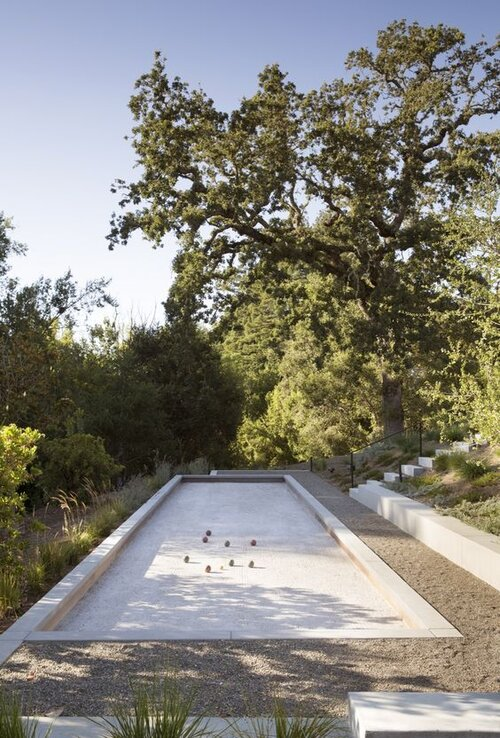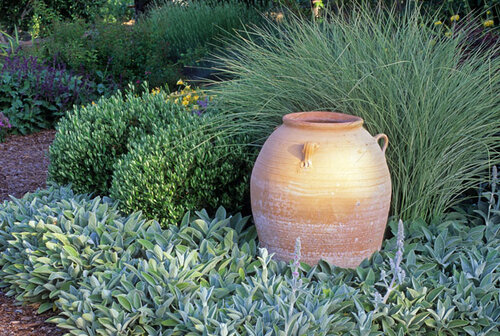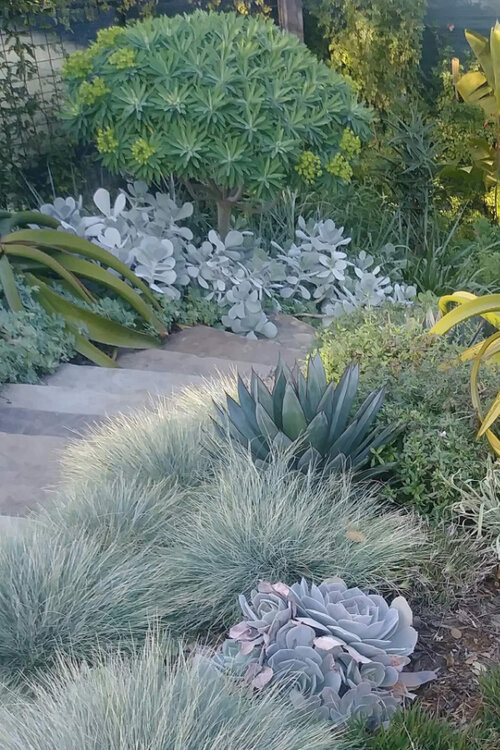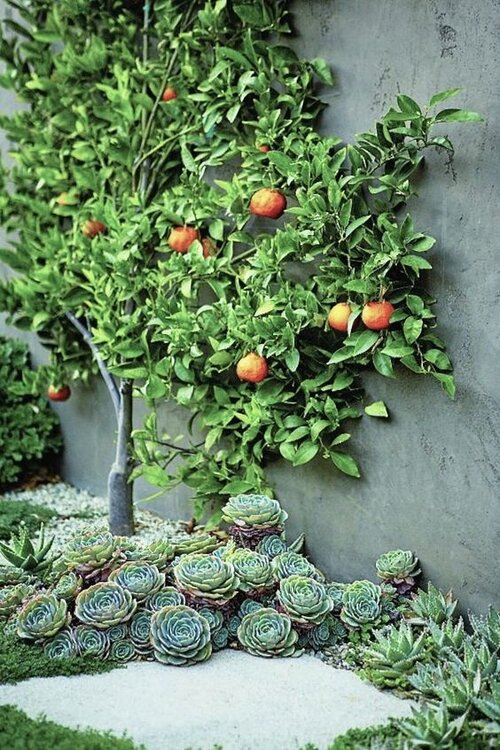The side garden of my 1920s Spanish-style home, which on my property is the principal "backyard," underwent a significant landscaping redesign effort this spring.
I'll show you how it turned out in a future article once it has filled in a bit more. I want to share with you my garden's "mood board" today. It's not a mood board in the conventional sense, but rather a collection of images I found on Pinterest that I used to gather design concepts before starting the actual design work.
Read my "mood board manifesto" which inspired me to write a course for more information on why mood boards are an essential first step in every design project and how to create your own.
My Mediterranean Landscape Design Mood Board
Several years ago, I've had an idea in my brain (and on a Pinterest board) of what I wanted to do with the garden—the kinds of things I wanted to include and the overall vibe. Let's look at this:
Garden design priorities
Pea gravel is lovely, permeable, inexpensive, and indestructible.
Native stone paving
Shade structures found in nature. I didn't want to construct a shade structure since I rarely find them to be attractive, they're expensive, and frequently they don't last well.
In the grand scope of a landscape redesign, bocce courts don't cost that much. I reside in Napa, California, often known as Wine Country, thus they can add value to a design when properly created and maintained.
Mediterranean plants that can withstand drought and are suited to California
Green, white, and lavender dominate the plant palette.
As I previously mentioned, I've had this Pinterest board for garden design for almost ten years now, so it was a terrific resource for reflecting back to me what I actually am drawn to. Both the camera and your Pinterest board, in my opinion, are truthful.
You will observe your own trends developing given enough pins and when considered comprehensively. Conversely, sometimes your Pinterest boards highlight things you weren't even aware you were into until you take stock and realize you have 25 pins of rustic limestone water troughs. What you think you want isn't necessarily what you get, and vice versa. (True incident:
Finding your "springboard" object is one thing I advise doing with each design endeavor. You feel genuinely inspired by this. It could be a picture or rug inside, a water feature outside, or a magnificent specimen tree, for example. Once you've determined your springboard, you have something to unite around, which makes it much simpler to imagine the rest of the design.
Try not to laugh, but pea gravel and natural stone served as my springboards in this situation. Yeah, I know—exciting, hot stuff! But bear with me: Concrete cracking is one of my obsessions; it drives me nuts (OCD much?) yet the water table in my neighborhood is very high (I have a well).
It is well known that I adore natural stone. When they find I've acquired yet another heavy stone table, object, etc., those who know me best shake their heads.
Putting practical considerations aside, I adore the romanticism that both pea gravel and natural stone evoke. It brings to mind picturesque old homes and estates from far-off places like Provence, Andalusia, Tuscany, and Morocco.
I gave my garden design board the moniker "Gravel Porn" in my imagination once it got a few pins due to the abundance of pea gravel images!
Additionally, gravel is a permeable surface that is more environmentally friendly than concrete. Instead of being directed to the storm drain system, it enables rainwater to seep through and recharge the aquifer below.
Because so much of the surface area in urban areas are paved, precipitation has nowhere to go and collects there, increasing the likelihood of flooding by up to 95% (trying to recall the exact percentage from a graduate school lesson).
Natural shade structure
I made the decision to avoid a standard overhead pergola shade construction fairly immediately after considering other options. They're pricey, they frequently don't hold up over time, and I rarely truly like them even when they're nicely made.
What do I actually adore? Instead of using a rusted or splintering shade structure, consider sitting among lovely trees that are shaded by their canopies.
Practical? Well, this method of achieving shade takes time. For some time, a freshly planted Charlie Brown Christmas tree won't provide good shading.
Vanity of grandeur? Maybe, but I figure that the money I save by not constructing shade may be used to buy bigger tree sizes, which is what I did. (In all honesty, I also caved and purchased two adorable umbrellas a month ago; I'll talk more about those in a later article.)
Lawn bowling also includes pétanque and bocce. (Bocce is the Italian word for it; pétanque is the French word.) As I already mentioned, bocce is very common in Napa, and St. Helena even has its own league, so I thought it would be great to incorporate that into the design. The dimensions are practically the same, so that or a lap pool! Unfortunately, the lap pool is not financially feasible, so bocce will have to do.
In addition, I always consider the ROI (return on investment) of remodeling, and an in-ground pool frequently doesn't produce a favorable ROI. On the other side, a bocce court in wine country adds value.
Your crops should be based on the climate first. The most surefire approach to having a successful garden is to select plants that are well-adapted to your local environment. Napa is situated in Northern California, which has a climate that is frequently described as Mediterranean, with moderate, rainy winters and dry, hot summers. (This is obviously an oversimplification because there are numerous sub-climates.)
We are fortunate to have an abundance of lovely flora that are suited to our temperate environment. However, there isn't much rain where we are.
Although certain tropical plants do well here (in fact, they do much better in Southern California's largely frost-free climate), it is advised to steer clear of any that need a lot of water (which is what makes a plant tropical). The same goes for more turf grass. I instead focus on plants that are indigenous to South Africa, Australia, California, and the Mediterranean. Each is distinguished by dry summers and damp but not icy winters.
I may choose from a variety of lovely plants native to these areas, and by sticking with those that are at least partially drought-tolerant, I can control my water usage. Additionally, California is currently experiencing yet another drought and new water restrictions have been implemented, which seems to be the new normal.
I still have a lot of color options even when working within the confines of flora that are suitable for Northern California. I choose to limit my color palette to greens, gray-green, lavender, and white, though. Not always, though. I adore the fuchsia bougainvillea that came with the house, and I also have some pink camellias, but I don't have any red or even yellow plants, even though these two colors would be simple to add because they go well with purple, lavender, and green.
You may view my whole Pinterest mood board for this project if these images appeal to you. I had a great time doing it and to be honest, I could have finished this post a little sooner if I hadn't been sidetracked by all the gorgeous pictures.
Here is my complete garden reveal, updated: California-Mediterranean Landscape Design: Napa Garden Reveal
Since the website doesn't notify you when I've responded, if you have any questions concerning the landscape design process, please leave them below and check back for answers. Enjoy creating your own ideal garden!













![How To Waterproof Your Plant Pots [5 Minute DIY]](https://blogger.googleusercontent.com/img/a/AVvXsEgH9Y9bMy5i1jeEXDVjrNritwSFcwnlvkV9bcBcsYZp8aLZUTesr0H1RAhYd3J3Em9ZVUIPmg8oyXFZ_Kjj0rwj6sG7n56kS75WWIX5vD32U6eIRgciFa02CnsovgXyidPktHlhcjMa7rJb0wZlvZpiovKsjPxGr60IZSHgbIKQKZdQivzJbcffRsjtMw=s72-c)


No comments:
Post a Comment